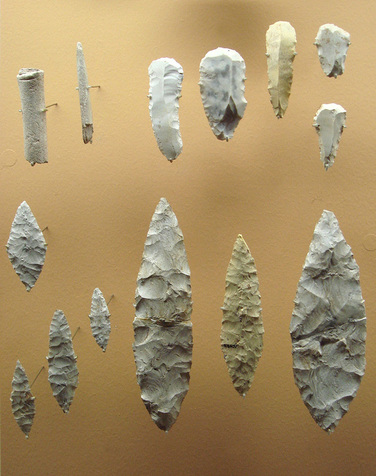 The standard illustration of Solutrean tools (Musee d'Archeologie Nationale).
The standard illustration of Solutrean tools (Musee d'Archeologie Nationale). A story two days ago seems to answer the question of whether The Solutrean will have anything to do with the Solutrean Hypothesis with a big "yes:"
"Inspired by the idea tossed around by some folks that Europeans settled in North America over 20,000 years ago, the movie . . . tells the Ice Age set story about a hunting trip the goes bad, and the tough journey home that follows."
And in this story:
"Specifically, the title “Solutrean” is a nod to a hypothesis written by scholars who believe that Europeans settled America somewhere around 20,000 years ago."
It sounds to me like they're writing from the same press release. So the film is, in at least some way, about the Solutrean Hypothesis.
I'm interested in the Solutrean Hypothesis (the idea that Upper Paleolithic peoples from western Europe colonized eastern North America sometime during the period 21,000 to 17,000 years ago) for a couple of different reasons. First, as a scientific idea, it relates directly to questions about the peopling of the New World and the earliest hunter-gatherers in the Eastern Woodlands. Like many other archaeologists, I'm open to possibility but remain unconvinced and unimpressed by the positive evidence that's been put forth so far (e.g., the Cinmar biface, the other bi-points reportedly recovered from Chesapeake Bay area, the genetic data, etc.). There have been reports of the discovery of Solutrean assemblages in sites with good context in eastern North America, but (as far as I know) those reports have been thus far limited to stories in the popular media (this story in Popular Archaeology, for example -- edited since I wrote about it here). I can't speak for others, but real publication of those sites is something I'm eagerly awaiting.
Not everyone is as skeptical as me. Some professional archaeologists apparently are convinced by what they've see so far, and it's pretty clear that the Solutrean Hypothesis has a strong following among non-professionals. My sense from comments I get on this blog is that many of you out there feel that the burden of proof has already been satisfied.
I disagree, obviously, and I think the contrast between how professionals and non-professionals generally view the Soloutrean Hypothesis and the strength of the evidence for it illustrates a good degree of daylight between how professional archaeologists and the public at large evaluate ideas about the past. I've been accused of "attacking" the Solutrean Hypothesis because I have expressed skepticism about the evidence, when, in reality, such skepticism is a basic, fundamental part of the process of doing science. Critical evaluation of positive material evidence is absolutely essential to the whole endeavor of understanding the past. I'm not sure when the Solutrean Hypothesis became so sacred and beloved that it was no longer permissible to ask questions like "what is that artifact really telling us?" or "what is the basis of that assertion?" News flash: those kinds of questions are never out of line. The Solutrean Hypothesis is far from being settled science. And, even if does turn out to be correct (i.e., the null hypothesis of "no North American visit by Solutrean-age peoples from Europe" is falsified by a good site), the door will never close on asking pertinent questions about the evidence and the interpretation of that evidence.
So now that we know that The Solutrean will indeed consciously embrace the Solutrean Hypothesis. It's a movie, of course, not science. But it will be interesting to see how the characters and story of The Solutrean engage and reflect both the scientific and non-scientific parts of the story of the Solutrean Hypothesis. What will the Solutreans look like? Will they encounter any other peoples in their journeys? Will they drop the Cinmar biface while traversing the Atlantic Shelf?
We shall see.


 RSS Feed
RSS Feed
